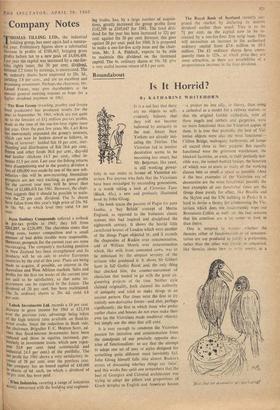Roundabout
Is It Horrid?
By KATHARINE WHITEHORN The book traces the passion of Pugin for pure Gothic, a `buy British' concept of Merrie England, as opposed to the ltalianate classic notions that had inspired and disciplined the eighteenth century. It shows the horrid little castellated houses of London which were another of the things Pugin objected to; and it records the rhapsodies of Ruskin over ornamentation, and of William Morris over ornamentation which, like milk from contented cows, was to be enhanced by the utopian serenity of the artisans who produced it. It shows Sir Gilbert Scott in full Gothic flood; and, the only thing that checked him, the counter-movement of classicism that tended to go with the great en- gineering projects of the time. Neither style claimed originality, both claimed the authority of antiquity and tried to make things to an ancient pattern. Our times were the first to try entirely non-derivative forms--and also, perhaps significantly. the first in which those who prefer earlier chairs and houses do not even make their own (as the Victorians made mearval objects), but simply use the ones that still exist.
It is easy enough to condemn the Victorian passion for imitation and ornamentation from the standpoint of our precisely opposite doc- trine of functionalism: to say that the attempt to adapt one set of uses or styles designed for something quite different must inevitably fail. John Gloag himself falls into almost Ruskin's errors of discussing whether things are 'false'; and this works fine until one remembers that the best of Georgian and Colonial architecture was trying to adapt the pillars and proportions of Greek temples to English and American houses --a project no less silly, in theory, than using a cathedral as a model for a railway station; or that the original Gothic cathedrals, with all those angels and corbels and .gargoyles, were no more functional than the Victorian copies of them. It is true that probably the best of Vic- torian objects were also the most functional-- Clifton Bridge, mahogany bathrooms, oil lampi all stayed close to their pUrpOse: But equally functional were the grimmest warehOuses, the bleakest factories, or even, in theiV Perfectly hor- rible way, the tunnel-backed housFs, the function of which was to cram as many of the working classes into as small ,a space as possible. (And if the best examples of the Victorian era of decoration are the most functional: possibly the best examples of our functional times are the things done purely for effect, like Brasilia and the Skylon and the UN building in Paris.) It is hard. to devise a theory for condemning the Vic- torians Which does. not inadvertently wipe' out Benvenuto.Cellini as well; yet the fact remains that -his creations arc a lot easier to look at than -theirs.
One is tempted to wonder %%hether the theories either of functionalisth or of ornamen- tation are not produced to justify a preference, rather than the other way round; or concocted, like theories about lieN% to poetry, as a
'1.3.rat Ilan for decorative 4agingl°
digest of how it has been. done so far: not much use in telling you how to do the next one. Possibly there is no such thing as a canon of taste, whether it is modern, Georgian or Vic- torian; maybe all we have is a succession of mere fashions in living, in which, from time to time and by simple luck, the pace-setter happens . to have been somebody with a good eye. For the generality of mankind is only really good at copying what it has seen. Whenever you get a prevailing acceptance of something that is agreeable to look at, 80 per cent. of the people accepting it are simply copying their neighbours, whether in the matter of white frame house's in America, or good wood and indoor plants in Finland, or chintz and Chippendale in contem- porary Britain. They don't know anything about art: they just like what they know.
Good taste is in the end simply a habit of the eye, to be improved (as in Scandinavia) by letting it rest mainly on delightful things, de- graded (as in the Five Towns) by giving it almost nothing of beauty to get used to. It is a matter of having your eye in; and on the evidence of this book at least, it seems that you can get whole generations which had their eye out— even if one or two clear-sighted people made lovely things on their own account. (One of the things that helped to keep the Victorian eye out, of course, was, the fact that they seldom saw any indoor item properly: bridges were better than most of their creations, not only because it is really quite difficult to build an ugly bridge, but also because one cannot have eight bridges on the mantelpiece on a piece of fringed velvet.) Arguably, there is too much of a beam in our own eye to start criticising the moated granges of Victorian medievalism; but there is one consoling factor about it all. E. M. Forster, in The Longest Journey, pointed out that one of the things that kept the philosopher Ansell and his grocer father from quarrelling was that neither of them had any taste; that taste, in fact, separates more than it unites. In fact, it goes further: unlike money, position or education, taste is something the lack of which never made people unhappy: by definition, they don't know they haven't any. There may have been things that worried the Victorians, bin their appalling bad taste certainly wasn't one of them.



































 Previous page
Previous page